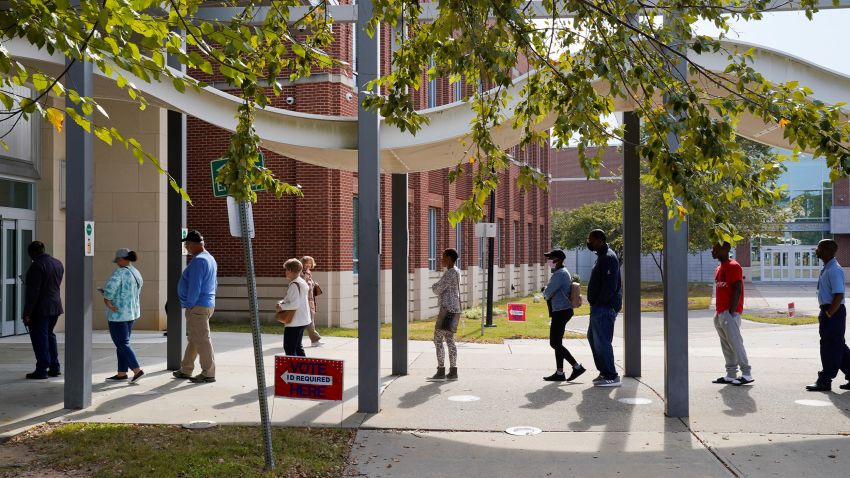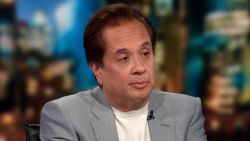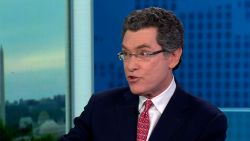A version of this story appeared in CNN’s What Matters newsletter. To get it in your inbox, sign up for free here.
When Democrats won the House in 2018, they did it with help from a great uptick in turnout that achieved the highest voter turnout for a midterm election in more than 100 years.
Still, half the voting eligible population didn’t take part.
This year, early voting has surged in some of the key states, but when I talked to Michael McDonald, the University of Florida political scientist known for tracking early voting data, he predicted turnout would fall below that 2018 level.
McDonald has a new book that dissects the massive achievement of the 2020 presidential election, when nearly 67% of the voting eligible population cast ballots. There’s more about the book and his early voting tracker at his US Elections Project website.
We talked about what people should take away from the last election and what he’s seeing as he tracks early voting data for the current election.
What’s below is a condensed version of our longer phone conversation.
Takeaways from 2020
WOLF: You’ve written a book about this kind of amazing democratic achievement of voting during a pandemic. What do you want people to take away from that research?
MCDONALD: We have to give a lot of credit to the election officials, volunteers who staffed polling locations, and the voters themselves for participating in an election at the highest turnout for presidential elections since 1900.
There was nobody alive that voted in the 2020 election that voted in the last election where we’d had higher turnout. That really is quite an achievement. We managed to do something that was historical under extraordinary circumstances. That’s the very positive news.
Unfortunately, the other takeaway from the book is the relentless attacks on voting that happened during the election, coming from the rhetoric with (former President Donald) Trump, and then just filtering on down through this party. That’s damaged democracy, and we can see that happening in real time with the 2022 election.
High turnout may be a symptom of extreme polarization
WOLF: You referred to the highest turnout in 100 years in 2020. I saw in the book that the turnout for the 2018 midterm was the highest since 1914. We’re seeing both that more people are questioning the integrity of elections but also that they’re taking part in elections more. What do you make of that?
MCDONALD: The last time that we had exceptionally high turnout was in the late 1800s, and that period was also marked by intense polarization. We don’t have any survey data so we can’t go back and ask the voters if they were polarized, but we can guess that what was happening among our elected officials at the federal government was also reflective of what was happening among the voters.
And so we’ve entered a period of higher polarization, and you can point to culprits for that. But whatever the cause, we’ve certainly reached a point where people really believe that it matters who is running the government and it really matters that their side is the one that is running the government.
When people perceive that difference between the parties and the importance the policy differences make on their lives, they’re more likely to vote.
It’s that old curse: May you live in interesting times. We live in interesting times. People are very interested in politics, and they are thus highly engaged in elections.
The happy medium of democracy
WOLF: In the 1880s, the US had close to 80% turnout. You could argue that the higher turnout signals an alarm bell for democracy in some ways.
MCDONALD: You would hope that people are engaged for altruistic reasons, that they want to be good citizens, they’re carefully weighing their options and coming to a reasoned determination of who they’re going to vote for.
There’s been some people who are looking back at a political science report that was done back in the 1950s and lamented that there was no difference between the political parties, we were falling apart, going towards a decay of democracy in the United States unless we fix the parties.
Lo and behold, you have to be careful what you wish for because the parties are stronger in the electorate than they’ve ever been in modern times, and now people are thinking, well, maybe that’s too much.
What is the happy medium of an engaged electorate, but one that’s not so inflamed by partisanship that they, in some cases, are wanting to take violent action because they believe that politics matters so much?
What early voting data tells us
WOLF: You are very well known for tracking early voting data. What can it actually tell us before Election Day?
MCDONALD: I first started tracking early voting back in the 2008 election for the exit poll organization. They wanted to know the size of the early votes, so they could do some proper weighting on their surveys.
And just as a lark, I posted it online. A million hits later to a website I created just as a lark, and I knew that I’d done something different and special in some ways. And if you look at a lot of the data journalism that happens today, it’s more in the vein of what I do, which is to take some administrative data and tell a story with it somehow.
To answer the question about where we are in the early vote … what you want to do is you want to take all the bits of information you can weave together and try to get a picture of where we are. So I don’t think early voting alone tells the picture just like I don’t think that polling alone tells you a definitive picture about where the election is going.
Polls have errors. Early voting has its nuances and measurement issues.
Turnout is not necessarily going to be high everywhere
WOLF: What are some of the things you’re seeing in the early vote?
MCDONALD: It’s not just that they are given a ballot or they have the opportunity to vote a ballot. They have to actually want to vote that ballot, and we’re certainly seeing a lot of interest in voting, especially in those really high-profile, high-tier elections that are going on for the US Senate or some of the gubernatorial races. Those seem to be drawing voters out.
What we’re seeing in those states is high levels of early voting. We’re seeing a lot of democratic engagement.
What we would typically see in a midterm election is that the party that holds the presidency would be punished somehow. For whatever reason, people find a reason to be enraged and engaged because of something that the administration has done.
But in these races we’re not seeing a sort of referendum on the Biden presidency. In fact, look at the polls: People who disapprove highly of (President Joe) Biden are still saying that they’re going to vote for the Democratic candidate. What’s happening here is that the election has moved into a choice between the candidates rather than a referendum on Biden.
If you look elsewhere in the country, we’re not seeing that same level of engagement. Lacking that engagement, the election becomes more of a referendum on Biden, and that’s where we could see a split outcome, like many of the polls are showing.
If Democrats do lose the House, it will likely be at least partially because their voters just didn’t find a reason to vote in a state like California.
As we entered this last week of early voting, that’s the challenge for the Democrats. How do you fire up your base to vote at the same level that the Republicans are in places where you don’t have this high-profile marquee race that’s driving people to the polls?
Does high turnout mean new voting laws did not suppress votes?
WOLF: Can we now assume that because of the high turnout in certain states and because so many people were making use of early voting, that some of those concerns about restrictive new voting laws were unfounded?
MCDONALD: I’ll give you a silly and completely ludicrous response to that. But there’s a point to it. You know what this election is? I see massive voter suppression happening in this election.
I look back at the 2020 presidential election and turnout is down across the board in every state. There has been massive voter suppression in this election.
Of course, you think that that’s ludicrous. It’s laughable because people vote in higher rates in presidential elections than midterm elections.
And just because you’re having an interesting race pulling people out to vote in a state like Georgia, that doesn’t mean that SB 202, which is the law that was passed in Georgia, somehow has made it easier for everyone to vote in the state. That does not mean that there’s certain communities that have not been left behind.
A good example of this, if you look at Georgia, is although we’re seeing record numbers of in-person, early voters, we’re seeing the mail ballots decreased by about half. And you may say, well, that’s OK. People who would have voted by mail, they’re just going to vote in person or they will vote on Election Day or early.
There could be some people who, for whatever reason, are home-ridden, and they are unable to make it to a polling location, and they must vote a mail ballot. And for those people, it may be that they are unable to participate to the same degree that other people in Georgia have been.
I’m not gonna say that just because there’s high early voting turnout going on in Georgia that means that the law had no suppressive effect for any particular community in Georgia.
Florida’s shift to the right
WOLF: Another emerging storyline from this election has been the shift toward Republicans in your state of Florida driven by a turn in the Hispanic and Latino vote toward Republicans. Is there anything from the early vote that either supports or disproves that? And do you agree with that larger narrative?
MCDONALD: We really can’t answer that question with the data that we have available, because we don’t know how people are voting.
On balance, the early vote in a typical election is usually won by Democrats, or at least registered Democrats. This election cycle it is the Republicans who are winning the early vote.
So far, as of (November 2), registered Republicans have an almost 180,000-vote advantage in both the mail ballots and the in-person early vote, and most of that advantage is actually coming from the in-person.
But still, all these Democrats have mail ballots. And here’s the curious thing: They’re not returning them. Not to the same degree or rate that the Republicans are.
So if you look at the return rate, as of (November 2), 48% of Democrats have returned their mail ballots compared with 55% of Republicans. So those are people who have a mail ballot in their hand, and you’re seeing a big disparity there in these return rates.
Part of what’s happening in Florida is a self-fulfilling prophecy that people who don’t believe that the Democrats can win are not voting. And because they’re not voting, the Democrats can’t win.
Will turnout continue to rise?
WOLF: Will turnout in 2022 eclipse the 2018 midterm?
MCDONALD: We’re gonna see high turnout. Georgia probably will eclipse their 2018 turnout. And other some other states like Pennsylvania might.
But it’s very possible that we’re not going to see the same level of engagement in some of the larger states like California, New York and Texas. And since most of the population lives in those large states and they don’t have the competitive elections that are pulling turnout, we may see some unevenness.
I don’t expect it to revert all the way back to 2014. That was the lowest turnout election since 1942. But I would not be surprised if we’re below 2018.


















